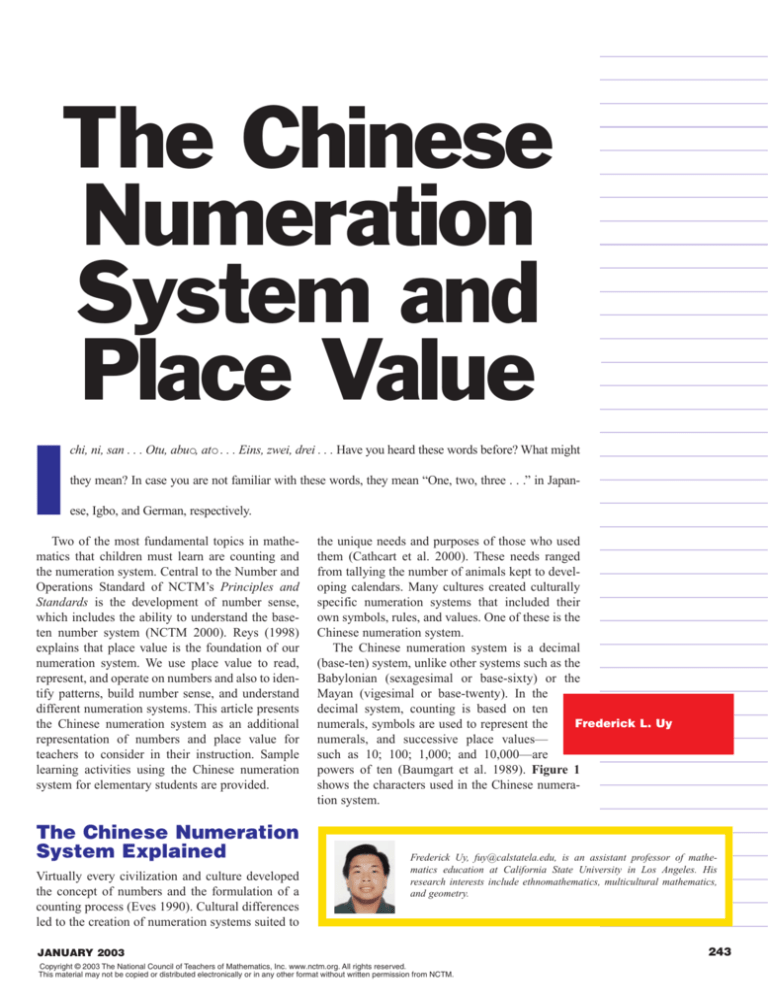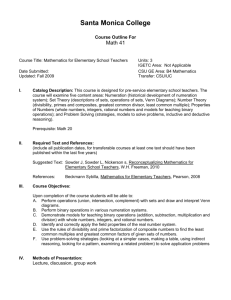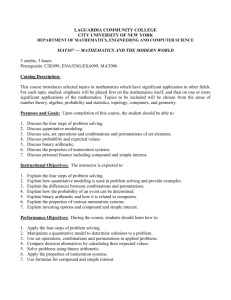
The Chinese
Numeration
System and
Place Value
I
chi, ni, san . . . Otu, abuo, ato . . . Eins, zwei, drei . . . Have you heard these words before? What might
they mean? In case you are not familiar with these words, they mean “One, two, three . . .” in Japanese, Igbo, and German, respectively.
Two of the most fundamental topics in mathematics that children must learn are counting and
the numeration system. Central to the Number and
Operations Standard of NCTM’s Principles and
Standards is the development of number sense,
which includes the ability to understand the baseten number system (NCTM 2000). Reys (1998)
explains that place value is the foundation of our
numeration system. We use place value to read,
represent, and operate on numbers and also to identify patterns, build number sense, and understand
different numeration systems. This article presents
the Chinese numeration system as an additional
representation of numbers and place value for
teachers to consider in their instruction. Sample
learning activities using the Chinese numeration
system for elementary students are provided.
The Chinese Numeration
System Explained
Virtually every civilization and culture developed
the concept of numbers and the formulation of a
counting process (Eves 1990). Cultural differences
led to the creation of numeration systems suited to
the unique needs and purposes of those who used
them (Cathcart et al. 2000). These needs ranged
from tallying the number of animals kept to developing calendars. Many cultures created culturally
specific numeration systems that included their
own symbols, rules, and values. One of these is the
Chinese numeration system.
The Chinese numeration system is a decimal
(base-ten) system, unlike other systems such as the
Babylonian (sexagesimal or base-sixty) or the
Mayan (vigesimal or base-twenty). In the
decimal system, counting is based on ten
Frederick L. Uy
numerals, symbols are used to represent the
numerals, and successive place values—
such as 10; 100; 1,000; and 10,000—are
powers of ten (Baumgart et al. 1989). Figure 1
shows the characters used in the Chinese numeration system.
Frederick Uy, fuy@calstatela.edu, is an assistant professor of mathematics education at California State University in Los Angeles. His
research interests include ethnomathematics, multicultural mathematics,
and geometry.
JANUARY 2003
Copyright © 2003 The National Council of Teachers of Mathematics, Inc. www.nctm.org. All rights reserved.
This material may not be copied or distributed electronically or in any other format without written permission from NCTM.
243
FIGURE 1
Photograph by Vanessa Uy; all rights reserved
What is unique about this numeration system?
The written form indicates the number of units in
each base, together with that base. For example,
the number 72 is actually written as seven ten(s)
and two (
). In contrast, in the Hindu-Arabic
system, the written numerals indicate digits that are
positioned accordingly, and each digit is a representation of a multiple of some power of the
chosen base (Eves 1990). Consider the number
564. The “5” has a value of 5(102), or 500; “6” has
a value of 6(101), or 60; and “4” has a value of
4(100), or 4. In the Hindu-Arabic system, the base
(10) is implied. Written in Chinese characters, 564
is
(5; 100; 6; 10; and 4), which literally means five hundred(s), six ten(s), and four.
In the Chinese numeration system, corresponding characters exist for 0–9 and for the multiples of
10, that is, 10; 100; 1,000; and so on. A number can
easily be rewritten from Hindu-Arabic to Chinese
by writing it in its expanded form, which gives the
actual value of each digit. For primary students, it
is suggested that a number be expanded as a sum of
its parts (Cathcart et al. 2000). An example is 745
= 700 + 40 + 5, or 7 hundreds + 4 tens + 5. For
intermediate students, the distributive property can
be used: 745 = (7 × 100) + (4 × 10) + 5 or (7 × 102)
+ (4 × 101) + (5 × 100).
Consider the number 15 and its expanded form,
10 + 5. Using the table in figure 1, 10 is represented
as
and 5 as . Therefore, 15 written in Chinese
will appear as
. Another example is 79. In
expanded form, 79 = 70 + 9. In Chinese, 70 is written as
and 9 as
, and the combination of the
two is
. The principle is the same for greater
numbers: 193 = 100 + 90 + 3. Putting the corresponding characters together for these numbers, 193
is
. These concepts also can be
extended to numbers in the thousands and ten thousands. If written properly, 2,745 in Chinese will
appear as
(two thousand[s], seven
hundred[s], four ten[s], and five) and 39,681 as
(three ten-thousand[s], nine
thousand[s], six hundred[s], eight ten[s], and one).
The Chinese numeration system
0 zero
10
ten
1 one
100
one hundred
2 two
1,000
one thousand
3 three
10,000
ten thousand
4 four
100,000
one hundred thousand
5 five
1,000,000
one million
6 six
7 seven
8 eight
9 nine
244
TEACHING CHILDREN MATHEMATICS
The Field Test
The activity in figure 2 was tried in a fourth-grade
class in Rio Vista Elementary School in Pico
Rivera, California. The students were Hispanic, and
English was not the primary language at their
homes. This lesson was chosen to serve as an extension of place value and to expose the students to a
different way to name numbers and express place
value than they would find in either Spanish or English. Before doing the activity in figure 2, the students were given base-ten blocks to use with placevalue activities. This served as a review of base-ten
concepts, expanded form, and groupings that represent numbers and acted as a bridge between concrete and symbolic representations of numbers. The
author and the teacher collaborated in introducing
and demonstrating the Chinese numeration system
to the students. After the lesson was conducted, students then were asked to complete Activity 1 and
write about their understanding of place value.
Two samples of student work are shown in figure 5. The first sample indicates that the student
could translate from Hindu-Arabic to Chinese readily and had a procedural knowledge of the value of
a digit, its place value, and its symbolic representation. In the second sample, the student wrote the
Chinese representation for each digit without writing the place value, or simply left them blank.
When asked why they did this, students who made
this mistake said that they translated exactly the
digits from Hindu-Arabic to Chinese and did not
consider the place values of the digits. This served
as a flag for the teacher to inquire into the understanding of these students. After doing the activity,
some students still seemed to experience difficulty
with place value and expanded forms of numbers.
The teacher then attempted to clear up the confusion by modeling the place values, using concrete
representations such as base-ten blocks while writing the expanded notations for each number.
JANUARY 2003
FIGURE 2
Activity 1: Complete the table below.
Number
(a) 398
(b) 751
(c) 576
(d) 307
(e)
(f) 7,500
(g) 80,427
(h) 38,074
Expanded Form
300 + 90 + 8
700 + 50 + 1
Chinese System
300 + 0 + 7
4,000 + 500 + 80 + 2
Benefits of the Lesson
Several benefits of this instructional approach were
noted. First, the activities reinforced the students’
knowledge of place value. According to the Number
and Operations Standard in Principles and Standards for School Mathematics, instructional programs should enable students to understand numbers, ways of representing numbers, relationships
among numbers, and number systems (NCTM
2000). These activities were aligned with the Standard. Furthermore, students first wrote the given
FIGURE 3
A natural question that will arise is, what if there
is a zero digit? If the zero digit is at the end of the
number, there is no issue. 5,300 will be written as
5,000 + 300; in Chinese, this is
(five
thousand[s], three hundred[s]). The more interesting scenario is when the zero digit lies in the middle of the number. Consider 6,028 and its expanded
form of 6,000 + 20 + 8. In a case such as this, it is
recommended that zero be considered a part of the
expanded notation. Therefore, 6,028 is better written as 6,000 + 0 + 20 + 8. Using the Chinese characters correspondingly, 6,028 now looks like
. Try writing 90,999 in Chinese. You
should get
. For sample classroom activities, see figures 2–4.
Activity 2: Use Chinese characters to write your answers.
Questions
Answers
(a) What is the value of “8” in
4,834?
(b) What year were you born?
(c) What year did Arizona become
a state?
(d) What is the weight in ounces
of an object weighing 1,032
pounds?
(e) How many times does your
heart beat in three minutes?
245
FIGURE 4
Activity 3: Answer the following questions.
1. Your classmate wrote 4,732 as
Is this correct or incorrect? Explain.
.
2. Write 378 in Chinese and how you will explain to a friend what the characters mean.
3. How do you think “ten million” is written in Chinese? Try it.
numbers in the expanded form before using Chinese
characters, demonstrating their understanding of the
relationships between the base-ten place values. The
students also reviewed the relationship between the
value of each digit and the total value of the numbers
as recommended by Heddens and Speer (1997).
When asked how to write numbers in Chinese, students said, “First you write the symbol for that number and then write the symbol for its value.”
A second benefit of the activity was that it created a foundation for students’ algebraic thinking.
The Chinese numeration system shows the number
of units in each base, along with that particular
base. This thinking involves the concepts of coefficients and “unknowns” (variables); that is, the
number of units in each base represents the coefficient, and the base is the variable.
Finally, this type of activity emphasizes the fact
that mathematics permeates all cultures and societies. Principles and Standards for School Mathematics recognizes that mathematics is part of cultural heritage. It states further that mathematics is
considered to be one of the greatest cultural and
intellectual achievements of humankind, and an
appreciation and understanding of that achievement must be developed (NCTM 2000).
An earlier study conducted by the author concluded that when a lesson is presented through a
cultural or historical connection, students see more
of the value and use of mathematics in the world
outside the classroom and gain a better appreciation for the mathematics that arises (Uy 1996). A
multicultural approach to teaching mathematics
can enable students to take pride in the accomplishments of their own people (Zaslavsky 1991).
Conclusion
The Chinese numeration system is one of many
numeration systems that can reinforce a student’s
246
conceptual knowledge of place value. Through the
use of Chinese numeration representations, students reviewed the base-ten place values in other
contexts. Introducing a different cultural perspective toward a mathematical concept shows students
that there are other ways to learn mathematics. The
sample activities presented use a multicultural
approach. You are invited to try them and offer
feedback about students’ mathematics learning
through them.
Some other suggested activities include examining the origin and history of the Chinese numeration system, researching other numeration systems,
comparing numeration systems, and reading numbers in different languages. Another suggestion is
to continue to have students write their reactions to
or reflections about the lesson. The students’ reactions and reflections will give teachers insights into
students’ understanding of and appreciation for
base-ten and other numeration systems. During the
study, one student noted that she finally understood
place value after being introduced to the Chinese
numeration system.
Students in today’s mathematics classes have
diverse backgrounds, and we teachers should
employ techniques and methods that will accommodate their needs. Maintaining meaningful
contexts for our lessons is essential. The use of
the Chinese numeration system to enrich students’ understanding of place value is only one
example of the many cultural numeration systems that you can investigate and share with
your students.
References
Baumgart, John, Duane Deal, Arthur Hallerberg, and Bruce
Vogeli, eds. Historical Topics for the Mathematics Classroom. Reston, Va.: NCTM, 1989.
Cathcart, W. George, Nadine Bezuk, Yvonne Pothier, and
James Vance. Learning Mathematics in Elementary and
TEACHING CHILDREN MATHEMATICS
FIGURE 5
Sample student work
Middle Schools. Upper Saddle River, N.J.: Merrill, 2000.
Eves, Howard. An Introduction to the History of Mathematics
with Cultural Connections. Orlando, Fla.: Saunders College Publishing, 1990.
Heddens, James, and William Speer. Today’s Mathematics.
Upper Saddle River, N.J.: Merrill, 1997.
National Council of Teachers Mathematics (NCTM). Principles and Standards for School Mathematics. Reston, Va.:
NCTM, 2000.
JANUARY 2003
Reys, Robert, Mary Lindquist, Nancy Smith, and Marilyn
Suydam. Helping Children Learn Mathematics. Needham
Heights, Mass.: Allyn and Bacon, 1998.
Uy, Frederick. “Geometry in the Middle Grades: A Multicultural Approach.” Unpublished doctoral dissertation.
Columbia University, May 1996.
Zaslavsky, Claudia. “Multicultural Mathematics Education
for the Middle Grades.” Arithmetic Teacher 38 (February
1991): 8–13. ▲
247






